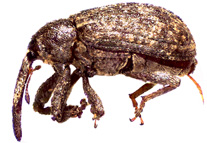Abstract
Three new species of the Afrotropical braconine wasp genus Bacuma are described, and biological observations (nectar feeding) by one of them are noted. The new species are: B. kayserae Quicke & Butcher sp. nov. from Kenya, B. madiensis Quicke & Butcher sp. nov. from Uganda and B. darfurensis Quicke & Butcher sp. nov. from Sudan. A group of four large nominal species with red metasomas and finely sculptured tergites (B. granulatus, B. maculipennis, B. rufa and B. whitei) may represent a single widespread species or a pair of species separated by mesoscutum colour, or four separate but morphologically very similar species. However, given the small number of specimens available for study and the poor condition of some of these, including the types, they are not formally synonymised here. A partial key to the species of Bacuma is presented, which recognizes those species that are clearly distinct, including three new species. Interactive Lucid dichotomous and matrix keys are available on www.waspweb.org.
References
Brues, C.T. (1924) Some South African parasitic Hymenoptera of the families Evaniidae, Braconidae, Alysiidae, and Plumariidae in the South African Museum with a catalogue of the known species. Annals of the South African Museum, 19, 1–150.
Buffington, M.L., Burks, R. & McNeil, L. (2005) Advanced techniques for imaging microhymenoptera. American Entomologist, 51, 50–54.
https://doi.org/10.1093/ae/51.1.50Buffington, M.L. & Gates, M. (2009) Advanced imaging techniques II: using a compound microscope for photographing point–mount specimens. American Entomologist, 54, 222–224.
https://doi.org/10.1093/ae/54.4.222Cameron, P. (1905) On some new genera and species of Hymenoptera from Cape Colony and Transvaal. Transactions of the South African Philosophical Society, 15, 195–257.
https://doi.org/10.1080/21560382.1904.9626440Cameron, P. (1906) Descriptions of new species of parasitic Hymenoptera chiefly in the collection of the South African Museum, Cape Town. Annals of the South African Museum 5, 17–186.
Cameron, P. (1909) Archiv for Mathematik og Naturvidensckab, Kristiania 30 (10), 26.
Cameron, P. (1911) On the parasitic Hymenoptera collected by Mr. A.J.T. Janse, Transvaal. Annals of the Transvaal Museum, 2, 173–217.
Huber, J.T. & Sharkey, M.J. (1993) Family Braconidae. In: Goulet, H. & Huber, J.T. (Eds.), Hymenoptera of the World: An Identification Guide to Families. Agriculture Canada, Ottawa, pp. 13–59.
Jones, O.R., Purvis, A., Baumgart, E. & Quicke, D.L.J. (2009) Using taxonomic revision data to estimate the geographic and taxonomic distribution of undescribed species richness in the Braconidae (Hymenoptera: Ichneumonoidea). Insect Conservation & Diversity, 2, 204–212.
https://doi.org/10.1111/j.1752-4598.2009.00057.xKerr, P.H., Fischer, E.M. & Buffington, M.L. (2008) Dome lighting for insect imaging under a microscope. American Entomologist, 54, 198–200.
https://doi.org/10.1093/ae/54.4.198Quicke, D.L.J. (1984) Two new genera of Afrotropical Braconinae (Hymenoptera: Braconidae) with a partial review of those genera with 'merinotoid' metasomas. Entomologist’s Monthly Magazine, 120, 37–45.
https://doi.org/10.1080/00222938700770031Quicke, D.L.J. (1987) The Old World genera of braconine wasps (Hymenoptera: Braconidae). Journal of Natural History, 21, 43–157.
https://doi.org/10.1111/j.1463-6409.1988.tb00115.xQuicke, D.L.J. (1988) Inter-generic variation in the male genitalia of the Braconinae (Insecta, Hymenoptera, Braconidae). Zoologica Scripta, 17, 399–409.
https://doi.org/10.1111/j.1463-6409.1988.tb00115.xQuicke, D.L.J. (1991) The Braconinae type specimens of G. Szépligeti in Budapest (Hymenoptera, Braconidae). Annales Historico-Naturales Musei Nationalis Hungarici, 83, 169–186.
Quicke, D.L.J. (20120 We know too little about parasitoid wasp distributions to draw any conclusions about latitudinal trends in species richness, body size and biology. PLoS One, 7, 1–9.
Quicke, D.L.J. & Koch, F. (1990) Die Braconinae-Typen der beiden bedeutendsten Hymenopteren Sammlungen der DDR. Deutsches Entomologische Zeitschrift, 37, 213–227.
https://doi.org/10.1002/mmnd.19900370403Shenefelt, R.D. (1978) Shenefelt, R.D. (1978) Braconidae 10. Braconinae, Gnathobraconinae, Mesestoinae, Pseudodicrogeniinae, Telengainae, Ypsistocerinae, plus Braconidae in general, major groups, unplaced genera and species. Hymenopterorum Catalogus, Nova Editio, Pars 15, 1425–1872.
Szépligeti, G. (1901) Tropischen Cenocoeliden und Braconiden aus der Sammlung des Ungarischen National-Museums. Termeszetrajzi Fuzetek, 24, 353–402.
Szépligeti, G. (1906) Braconiden aus der Sammlung des ungarischen National-Museums, 1. Annales Historico-Naturales Musei Nationalis Hungarici, 4, 547–618.
Szépligeti, G. (1914) Afrikanische Braconiden des Konigl. Zoologischen Museums in Berlin. Mitteilungen aus dem Zoologischen Museum in Berlin, 7, 153–230.
van Achterberg, C. (1981) The position of the genus Rhamnura Enderlein among the Braconidae (Hymenoptera). Entomologische Berichten (Amsterdam), 41, 88–91.

